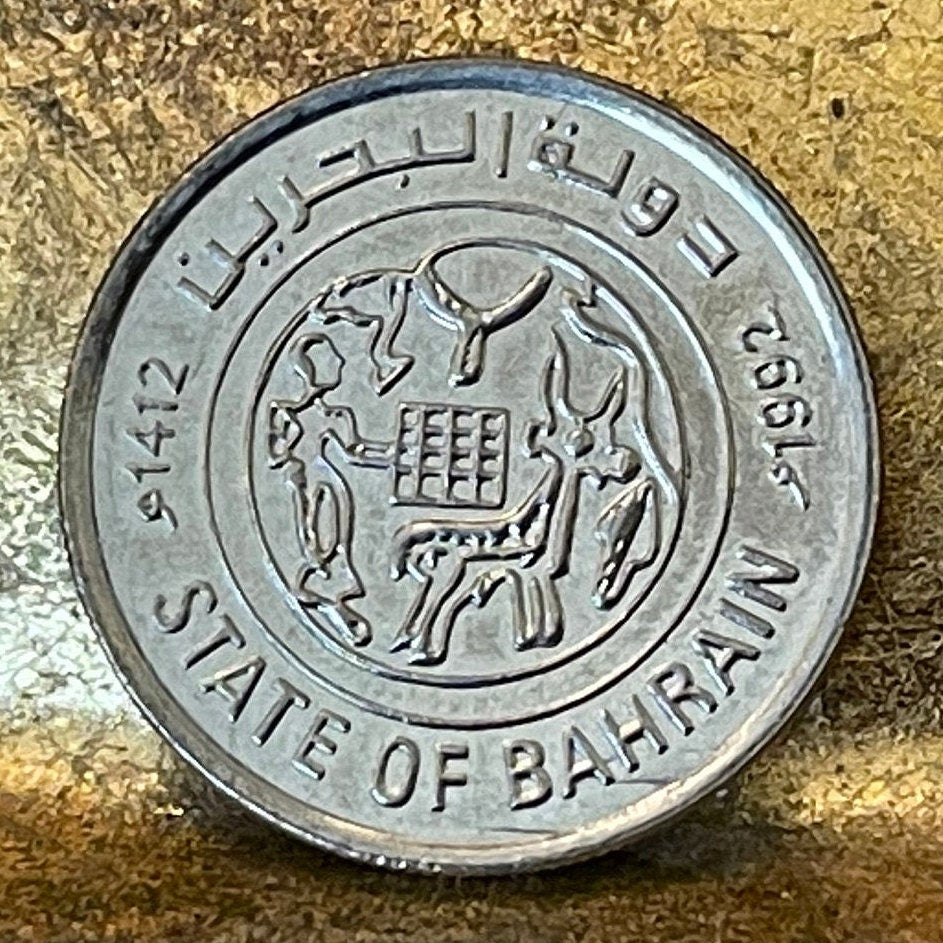elemintalshop
Man Pens Goat Ancient Dilmun Seal 25 Fils Bahrain Authentic Coin Money for Jewelry and Craft Making (Playpen)
Man Pens Goat Ancient Dilmun Seal 25 Fils Bahrain Authentic Coin Money for Jewelry and Craft Making (Playpen)
Couldn't load pickup availability
Man Pens Goat Ancient Dilmun Seal 25 Fils Bahrain Authentic Coin Money for Jewelry and Craft Making
Obverse: Seal of Dilmun civilization (ancient painting with goat, man, rectangular pen, within circle). State name in Arabic and English. Islamic and Gregorian dates in English.
Lettering:
دولة البحرين
مـ 1992 هـ 1412
STATE OF BAHRAIN
Translation:
State of Bahrain
AH1412 - AD1992
Reverse: Numeric denomination back of boxed denomination within circle. Chain border.
Lettering:
25
فلس
Translation: 25 Fils
Features
Issuer Bahrain
Ruling authority Isa bin Salman Al Khalifa (1961-1999)
Hamad bin Isa Al Khalifa (1999-date)
Type Standard circulation coin
Years 1412-1420 (1992-2000)
Calendar Islamic (Hijri)
Value 25 Fils
0.025 BHD = USD 0.07
Currency Dinar (1965-date)
Composition Copper-nickel
Weight 3.5 g
Diameter 20 mm
Thickness 1.5 mm
Shape Round
Technique Milled
Orientation Medal alignment ↑↑
Number N# 5372
References KM# 18, Schön# 15
For important business practices and to document their lives and culture, the ancient people of Dilmun captured their stories and successes through extraordinary pieces of art known as Dilmun Seals. Dilmun seals are tiny works of art of exceptionally high quality. The designs which are engraved on the face of the seals are miniature masterpieces, vibrant, alive and often beautifully conceived.
The seals depict every day life and legends of the time - scenes of hunting and chasing; men and animals; gods; mythical scenes and frequently a wide variety of symbols such as stars, the foot, the scorpion, the crab and the graceful ibex.
As a record of history, their importance is unmatched, containing much information about the character of life in the Gulf at the time. The images carved suggest they were most probably used to identify property, to notarise contacts and transactions, and as trademarks and amulets. They were also used for branding goods, for the authorisation of individuals and merchants, and to proclaim the status of their owner.
Source: http://heritage-bh.com/dilmun-seals.ph
**********
Wikipiedia:
Dilmun, or Telmun, (Sumerian: Dilmun (early Sumerian pictograph).jpg, later 𒉌𒌇(𒆠), ni.tukki = DILMUNki; Arabic: دلمون) was an ancient Semitic-speaking civilization in Arabia mentioned from the 3rd millennium BC onwards. Based on contextual evidence, it was located in the Persian Gulf, on a trade route between Mesopotamia and the Indus Valley Civilisation, close to the sea and to artesian springs. A number of scholars have suggested that Dilmun originally designated the eastern province of Saudi Arabia, notably linked with the major Dilmunite settlements of Umm an-Nussi and Umm ar-Ramadh in the interior and Tarout on the coast. Dilmun encompassed Bahrain, Kuwait, Qatar and the eastern portion regions of Saudi Arabia. This area is certainly what is meant by references to "Dilmun" among the lands conquered by King Sargon of Akkad and his descendants.
The great commercial and trading connections between Mesopotamia and Dilmun were strong and profound to the point where Dilmun was a central figure to the Sumerian creation myth. Dilmun was described in the saga of Enki and Ninhursag as pre-existing in paradisiacal state, where predators do not kill, pain and diseases are absent, and people do not get old.
Dilmun was an important trading centre. At the height of its power, it controlled the Persian Gulf trading routes. According to some modern theories, the Sumerians regarded Dilmun as a sacred place, but that is never stated in any known ancient text. Dilmun was mentioned by the Mesopotamians as a trade partner, a source of copper, and a trade entrepôt.
The Sumerian tale of the garden paradise of Dilmun may have been an inspiration for the Garden of Eden story.
********
Comparison:
Stamp seal: hunters and goats, rectangular pen (?)
ca. early 2nd millennium B.C.
Dilmun. On view at The Met Fifth Avenue in Gallery 403
The earliest stone seals of the Gulf region were made of steatite hardened by firing and often glazed after they were carved. The impression of the hemispherical stamp seal depicted here shows a male figure in the upper field who grasps a caprid by the neck. To the left, a male figure holds a staff. Below, a recumbent caprid reclines beneath a gridded rectangle. A snake and perhaps a monkey(?) are also depicted in the field. The hemispherical form and round sealing face are typical of seals of the Gulf region, as are the incised lines and concentric circles that decorate the back of this seal. Similar seals have been found in Mesopotamia, Iran, and the Indus Valley, areas with which Gulf merchants traded and with whom they shared a common visual vocabulary.
https://www.metmuseum.org/art/collection/search/327300
Share










5 stars review from Sian
Neat and intriguing! I'm going to enjoy telling people 'Man pens goat' if they ask about this coin. The uniqueness and background of this coin just makes me happy.









